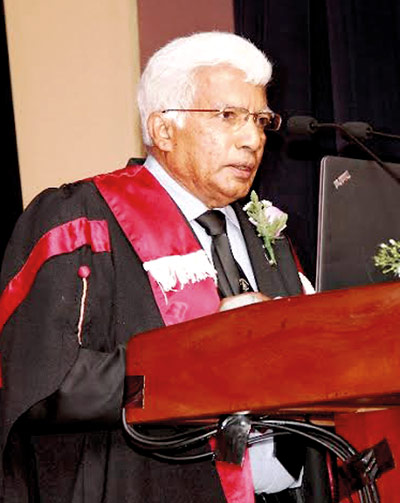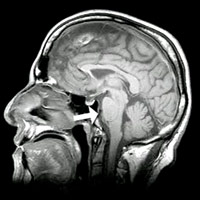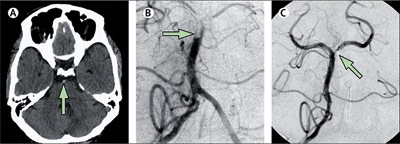My story
I was a perfectly healthy individual who had only a mild elevation of blood pressure, kept under control with medication. I did not smoke and always had normal cholesterol levels and blood sugar. A very active seventy two to boot.

Prof. Ratnatunga addressing the gathering as Guest of Honour at the induction of the new president of the College of Surgeons of Sri Lanka in January 2015
In March of 2015, I had a stroke. It was a ‘Basilar stroke’, the worst kind. When afflicted by this kind of stroke, one usually died 80-90% of the time if no active treatment was done.
As you can see I survived and am writing this, eight months into rehabilitation. I am walking around the house now and am able to function almost independently. The progress has been steady though slow.
I am confident that I will be able to reach a normal level of functionality within the next few months. The journey from March up to now has been challenging to say the least, for all concerned.
I feel that my story will help many out there who are afflicted by, or are caring for someone suffering from a stroke, as well as open the eyes of those who are yet to face this challenge, on the treatment options that are now available.
I also hope to motivate the powers that be to invest in the technology that helped save my life, so that it may be made available to all.
I write my story with the hope that it will inform all who suddenly have to make decisions as to what to do when a near and dear one is afflicted with a stroke.
I am a doctor working in Kandy and was in hospital at the time going about my usual routine, when I suddenly felt dizzy. I had a sense that something was amiss and a little more out of the ordinary than just feeling under the weather.
Having sat down, I soon found myself collapsing and unable to speak or swallow. And so it began at about 5 p.m. that Saturday at the end of March 2015.
A large blood clot had wedged itself in a major artery (Basilar artery) that supplied the lower part of my brain, – the brain stem. My saving grace was that this event happened at a hospital, where my colleagues Dr. Vasanthi Pinto and Professor Indika Bandara Gawarammana among many others were on hand to assess, diagnose and respond within minutes.
Thanks to the tireless efforts of Dr. Manoji Pathirage, Dr. Indunil Wijeweera, and many other doctors, I was rapidly administered medication to dissolve the clot in my brain that had made me by this time paralysed.
With hours ticking by, there was no improvement. I had been made unconscious to minimize the damage to my brain. I was in the ICU overnight at the Teaching Hospital Kandy.
The following morning CT scans were done to assess whether the medication given to dissolve the clot had done its job. However it was not to be and things were looking ominous.
My colleagues in Peradeniya and Kandy hospitals, many of them my students, too many to mention individually, rallied around me, and did everything possible in Kandy. I am ever thankful to them.
After much deliberation, my colleagues, along with my family decided to move me to a private hospital in Colombo, which had a team of skilled doctors able to perform a procedure which would extract the clot from the artery in my brain.
This procedure is relatively new to Sri Lanka though practised in some technologically advanced centres abroad.
I, who was unconscious and on a ventilator in the Neurosurgical ICU at the Kandy Teaching Hospital at the time, was to be airlifted by helicopter courtesy of Sri Lanka Air Force, arranged by my colleagues, to whom I am eternally grateful. Time was of the essence. Already twenty hours had elapsed.
I was airlifted under the expert care of Dr. Udaya Karunaratne who ensured that I was kept alive during the transfer.
I was pleased to learn from my son (who accompanied me), himself a doctor at the National Hospital of Sri Lanka (NHSL), that the skilled Air Force pilots flew low over the hills, in order to prevent any drop in atmospheric pressure which could have been lethal to me. It took only thirty minutes flying time to arrive in Colombo.
I was picked up at the airfield by a waiting ambulance, and whisked off to the Central Hospital on Norris Canal Road. A highly skilled team consisting of two Interventional Radiologists: Dr. Nihal Wijewardena, Dr. Lakmalie Paranahewa and a Stroke Physician Dr. Thurul Attygalle immediately took me up for the procedure.
Because I had arrived some 20 hours after the event which was well outside the recommended interval for performing this procedure, they hesitated at first, but eventually decided to take on the challenge.
I am glad that my colleagues decided to do so, intervention giving me the best chance of a recovery, by removing the clot.
Within minutes, I gather, they had inserted a catheter through my femoral artery in the upper thigh and had reached the basilar artery in the brain and taken the clot out.
The skill required to navigate to and reach the Basilar artery in the brain from my thigh, in the first attempt, for those who know the perambulations of the human arterial tree, beggars description.
We in this country know little of what human treasures we have, who go about their normal work without much ado, unheard, unsung. I am personally ever grateful to them.
I regained consciousness next morning. It was a Monday. I could feel my whole body, my mind was normal, but all four limbs were paralysed. I could move only my eyelids.
“It’s called the locked in syndrome”. However my children devised a method of getting me to communicate by blinking on a written alphabet they held up. I was in touch at least with the world outside!
As I was at risk of inhaling my own saliva and whatever liquids I drank, Dr. Attygalle, in consultation with the NHSL Neurologist Dr. Padma Guneratne, recommended that I have a tracheostomy (a tube through my neck, to the airway so protecting it) and a tube inserted into my stomach (percutaneous endoscopic gastostomy-PEG for feeding) which were expertly done by Dr. R. P. Dayasena and A. Somaratne respectively.
They were safely done by them despite me being on a blood thinning drug which won’t allow the blood to clot.
To cut a long story short, I was transferred after one week at the Central Hospital ICU.
I was fortunate to be offered care in the Neuro-trauma ICU II at the National Hospital of Sri Lanka. (NHSL), after a confirmatory MRI and MRA which showed up a significant area of infarction in my brain stem.
I was under the expert care of Neurologist Dr. Padma Guneratne and Neurosurgeon Dr. Saman Wadenambi (both happened to be my students), and the Consultant Anaesthetist, Dr. Shirani Happuarachchi leading a team of intensive care doctors and nurses.

Arrow showing the region of the brain where the Basilar artery is located
They offered me a level of medical care I would be hard pressed to find anywhere in the world. I was looked after royally by the nurses and the minor staff under Sister Wijeyanthi who was the Sister in-charge of the ICU.
The quality of care I received at this unit was par excellence. Having spent 40 years in the government health sector myself as a doctor, I suddenly realized how hard the ICU nurses worked under difficult conditions and hours, and the sacrifices and compromises they had to make in their personal lives, due to their unwavering commitment to their profession.
The brilliant team of Physiotherapists in the Neuro-trauma unit, under Amal Gunerathne, were miracle workers.
The team including Mahesh Herath, Eranga Gunawardane, and Lahiru Laknath, coaxed my completely paralysed body to walk within four months; a feat almost unheard of in patients suffering a brain stem stroke.
I had almost complete paralysis of my hand muscles which made it impossible for me to achieve the simplest of manual tasks.
I couldn’t even press a button on a bell or hold a pen, let alone write. Daily occupational therapy sessions by the dedicated, ever–patient Ms. Lasanthi Siriwardana, occupational therapist of the Neurology Rehabilitation Unit under Dr Padma Guneratne at the NHSL helped me progress to a level that I could hold a pen and scribble illegibly at four months to legible formed writing by seven months.
Initially I could not speak, swallow nor make any form of facial expression due to the paralysis. From that state to my current ability to eat and drink normally with full facial muscle control and near normal speech was due to the hard and patient work put in by Ms. Prabhani Dineshika, Asanka Weerasinghe and Asanka Wijerathne, speech therapists of the team at the Speech and Language therapy unit at NHSL.
After four months of intensive rehabilitation at NHSL I came home to Kandy where I have been on a regimented physiotherapy and rehabilitation schedule under the able guidance of Senaka Divaratne and his team at the Peradeniya Teaching Hospital, where I had worked for the better part of my life.
I am now close to normalcy with the tracheostomy, urinary catheter and PEG out, and ambulant without support, inside the house, though I have made a few sorties outside. Considering the significant delay wherein there was a relative shortage of blood supply to my brain stem, I am very lucky to have escaped almost scot free.

Picture of an angiogram showing a clot in the Basilar artery. Pic courtesy the Lancet
Having since gone through the medical literature I was surprised to find that in the current day and time, it is not only that the stroke could be prevented but it could be effectively treated with many newer modalities of treatment. Many of these facilities are not known to most Sri Lankans.
Knowledge on the urgent need for treatment and the availability of basic and advanced facilities in major hospitals would avert disability and many deaths that are caused by this deadly disease, stroke.
Intensive care for stroke patients, facilities for dissolving the clot by the clot buster within the first 4.5 hours and removing the clot stuck in bigger blood vessels within six hours, and multi-disciplinary rehabilitation in stroke units are basic facilities that should be established in any teaching hospital including in my own district Kandy.
In the meantime the facility and the expertise, exists in Colombo, in the hospital that attended to me. In the event of a stroke, the attending stroke physician decides on the nature of the stroke, its cause and whether it is amenable to intervention.
Most stroke units in the western world offer immediate dissolution of the clot and if it fails -which occurs about fifty percent of the time- would attempt its removal by the procedure that I underwent.
That is to take it out by ‘interventional radiology’. If the patient arrives at the Stroke centre within four hours, (some even say eight hours) the result is likely to be significantly better e.g. “sometimes be able to walk out of the hospital in the next few days”. That such a facility exists in Sri Lanka, unheard and unsung, was an eye opener to my family and myself.
I am writing this to make the public aware of this facility which enables better results from this common ailment. It is very important to bring your patient to the unit as early as possible for any form of treatment.
I am aware that to equip an interventional lab to perform this procedure is rather expensive. But when one thinks of the cost of rehabilitating a stroke patient and the handicaps he/she will have afterwards, it is well worth it– certainly well within the national budget for health.
Now that budgetary provision has been allocated for stroke units, the Ministry of Health, should go ahead by first establishing them in the government teaching hospitals.
I would like to substantiate what I say to the doctors in the readership by asking them to read the reputed New England Journal of Medicine in January and June of 2015.
I would like to digress a bit at this stage. In 1975 a close friend of mine, Dr. Gamini Wijesekera (who unfortunately died in the bomb blast on that tragic day in the port some years ago) often told me of the trials and tribulations of the Consultant Physician Dr. Ivor Obeysekera whom he had worked with.
At that time, Dr. Obeysekera was the appointed Cardiologist to the General Hospital Colombo, and his dream was to establish a Cardiology Unit in the hospital. The impression he gave me was that Dr. Obeysekera’s own colleagues with vested interests brought up several arguments opposing this venture.. eg
“ heart patients belong to the old non-contributory section of society, so why spend money on them.”.They had claimed that they had the experience to look after the heart patients in the general wards.
Like the true pioneer that he was, Dr. Ivor Obeysekera fought tooth and nail and today we reap the benefits of a Cardiology Unit on par with those anywhere in world – thanks to him and the yeoman service rendered by the many distinguished Cardiologists who followed.
I quote the above anecdote to indicate how difficult it is to establish a unit in this country. I reiterate, we are in desperate need of stroke units in every district. They will definitely save lives and certainly minimise the handicaps that such persons suffer.
Like the cardiology units that have since proliferated throughout the country, and have been doing yeoman service all over this land, Stroke units too are needed to fill the huge void in the prevention and treatment of this common Non Communicable Disease (NCD) in Sri Lanka.
Several individuals have been trying their best to pioneer interventional therapy in Sri Lanka which has been an up hill struggle so far. They need public support to garner a receptive ear from the powers that be.
To reiterate, stroke care has been given stepmotherly treatment by the (public) health sector. There is now hope with the thrombolytic (clot dissolution) drugs, and this new procedure, to give a better deal to stroke patients.
I am in debt to all my colleagues and staff in Peradeniya and Kandy hospitals, Suwasevana Hospital Kandy, Asiri Central Hospital Colombo, and the National Hospital of Sri Lanka, for their untiring efforts to support my recovery.
I have to thank all my family members, friends and colleagues who supported me during my long journey, and my wife and two children, without whose daily unstinted care and concern, this dramatic recovery, would not have been motivationally possible.


